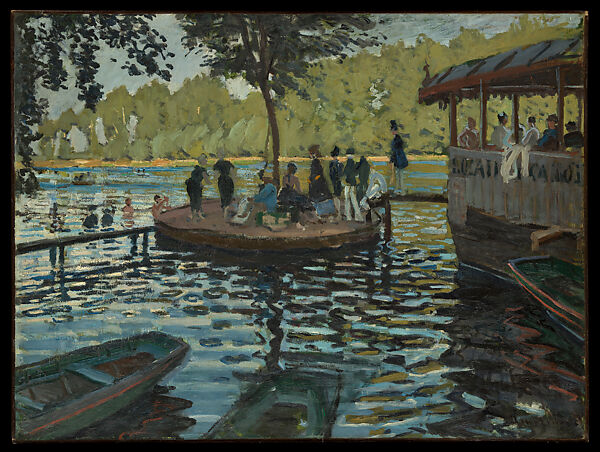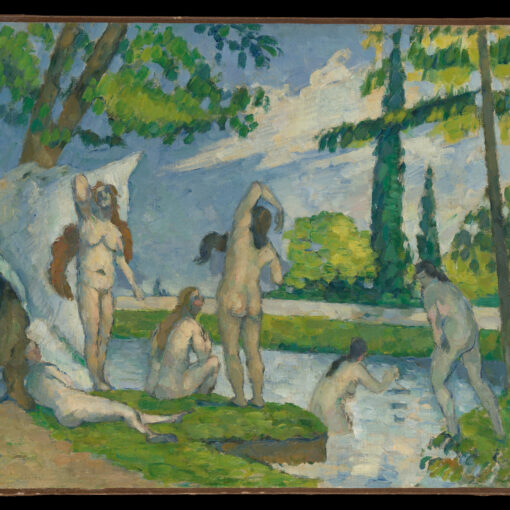
La Grenouillère, Claude Monet, 1869
By Anahi Benitez
The first thing that came to my mind when I think about “La Grenouillère”, it is a feeling like a snapshot of a moment frozen in time—a brief dance of light, color, and reflection. In this painting, Monet shows us more than just a peaceful riverside scene. He draws me into a fleeting experience: the ripples on the water, the shadows playing on the trees, and the movement of life that seems to go beyond the stillness of the canvas. For me, La Grenouillère is not just about the beauty of nature; it’s a reminder of how moments pass by so quickly, leaving only faint traces behind. Monet’s quick, lively brushstrokes reflect the short-lived beauty of our own experiences—beautiful and fleeting yet lasting in our memories.
Claude Monet’s painting La Grenouillère, created in 1869, is a great example of the Impressionist style. It shows a lively spot on the Seine River where people relax at a floating café and enjoy a sunny day. Through his unique use of art elements and principles, Monet brings this scene to life, highlighting his love for light and color.
One of the most noticeable elements in La Grenouillère is color. Monet uses bright colors to capture the changing effects of sunlight on water. He mixes cool blues and greens with warm yellows and oranges, creating a lively contrast that makes the water shimmer. The colors are applied with broad, loose brushstrokes, which help them blend and show how light dances on the surface of the water. This technique makes the scene feel vibrant and inviting, allowing viewers to feel the joyful atmosphere.
Line is another important element in the painting. Monet uses smooth, flowing lines to show movement and energy. The curving strokes of the water give a sense of motion, while the diagonal lines of the café help guide the viewer’s eye around the painting. These lines add structure to the artwork and emphasize the fun and carefree spirit of the scene.
Texture also plays a key role in the painting’s impact. Monet’s brushwork creates a rich texture that adds depth. The visible brushstrokes suggest the surface of the water, making it feel as if viewers can almost touch the ripples and reflections. In contrast, the café and people are painted with clearer textures, highlighting their importance. This mix of textures emphasizes the difference between the solid objects and the fluid water, capturing the lively feel of a summer day.
Monet’s use of form is important as well. While the figures and objects are somewhat abstract, they still have recognizable shapes that connect them to reality. The way he paints the bathers shows a balance between abstraction and clear representation, allowing viewers to see what the people are doing while appreciating the overall picture. The play of light enhances the three-dimensional quality of the forms, especially in the water, which looks like it is shimmering.
The principles of art are clear in La Grenouillère, especially in terms of balance and emphasis. The painting has a sense of balance because the bathers are evenly placed across the canvas. This arrangement creates a visual harmony that draws the viewer’s eye throughout the scene. The café, with its bright colors and more detailed look, stands out as the focal point, emphasizing its role as a social center amid all the activity.
Movement is another principle that Monet captures well. The lively poses of the bathers and the gentle ripples in the water create a strong sense of motion, inviting viewers to connect with the scene. This movement embodies the joy and fun of leisure time, making the audience feel as if they are part of that moment.
Finally, unity brings the whole painting together. Despite Monet’s free brushwork, the consistent color scheme and theme create a harmonious feeling among all the elements. The painting celebrates shared experiences of joy and leisure, capturing the spirit of summer at La Grenouillère.
In conclusion, Claude Monet’s La Grenouillère showcases his skill in using the elements and principles of art. Through his creative use of color, line, texture, form, and composition, Monet captures a lively moment in time, inviting viewers to enjoy the beauty and energy of a sunny day by the Seine. This work reflects the heart of the Impressionist movement and highlights Monet’s talent for turning everyday scenes into extraordinary experiences.



